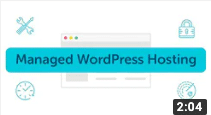A Complete Guide to YouTube Video Marketing for Web Designers
YouTube video marketing isn’t necessarily a new topic. Video is growing in popularity every day and it’s more important than ever to understand your video strategy, as well as how to optimize your videos for YouTube.
For web designers, video can be a great tool to market yourself or the tools you swear by. Whether you’re hoping to spread your knowledge by creating design or dev tutorials, post reviews of your favorite WordPress hosts, or walk through a specific tool that helps you with your workflow, knowing how to execute a solid YouTube video strategy is imperative in 2020. Let’s dive in.
Here are the steps to understanding YouTube video marketing:
- Know your audience
- Dig into competitor content
- Create videos
- Optimize for SEO
- Use other channels to distribute
Know Your Audience
The first step when creating any new content for a channel is to know your audience. Once you know who that is, you’ll be able to tailor your video content and distribute it in a way that not only makes sense to that audience but also adds value for them.

Here are some things to think about when deciding who your audience is:
- What are their demographics? (Age, race, ethnicity, gender, marital status, income, education, etc.)
- What are their psychographics? (Personality traits, attitudes, aspirations, beliefs, values, interests, hobbies, etc.)
- What do they care about?
Some of these may not be relevant to the types of videos you’re creating. For example, if you want to create a video tutorial about creating a neon glow effect in Photoshop, things like marital status and gender may not be a factor. Answer the questions to try to narrow down your audience as much as it makes sense; don’t try to force it.
Once you’ve locked in your audience, it’s time to move on to the next step: digging into competitor content.
Dig into Competitor Content
Let’s do some digging into your competitor content. I’m using the word “competitor” loosely here, as it may actually be a competitor, but it might also be another channel that is similar to how yours will look. For this instance, think of competitor content as “similar content.”

The easiest way to start this is by jumping into your audience’s shoes and learning what YouTube channels and video content (besides yours), they are searching for. Start a list of the most similar competitors. These are channels that have a similar number of followers, a similar style you were thinking of, or they produce the exact same content you are planning to.
Once you have that list, go ahead and start digging into each one and take note of things that you like, and don’t like. Maybe you like the video style, but don’t like that the person says “um” or goes off on tangents all the time. Why does this matter to you? Well, now you know that you want your videos to have an organized outline or that you should prepare a script to avoid the “um’s”.
Let’s say you like a channel because it has a TON of content, but they aren’t utilizing the playlists feature, so it’s disorganized and hard to navigate. This is important for you to note so you can start thinking of future playlists and videos while you’re brainstorming content ideas.
This research may feel time-consuming, but I promise it will come in handy, and save you a ton of time later on down the road when you’re ready to optimize your videos and channel!
Create Videos
Now it’s time for the fun part, actually creating the videos! Depending on where you are in this process, you may already have some videos, in which case, you can skip to the next step: optimizing. But, for those who are getting started, let’s dig into the steps for creating videos.
Here are the six steps for creating videos:
- Define the goal
- Decide the video format
- Write the script
- Draft a storyboard
- Pick a location and talent
- Shoot the video
Define the Goal
The first step when creating a video is to understand the goal. This may be different from video to video. You may want to inform people about a product or give a review in one video and give a tutorial of a specific tool with your favorite WordPress host in the next. For each new video, define a goal that will help with the next step: deciding the video format.
Decide the Video Format
When you’re creating videos for YouTube, your videos will (most likely) fall into one of three categories: promotional, tutorials, or “just for fun” videos. Each type of video has its own style and will serve different purposes.
If you decided in the last step that the goal of a video is to inform, chances are your video format probably won’t be just for fun. It’s more likely that it would be a tutorial or even a promotional video.
Let’s dive into each video format and give some more context.
Promotional videos
Promotional videos promote your business, company, product, etc. These can be videos about product features, customer testimonial videos, or anything else that helps the efforts in what you’re trying to sell or promote. Your audience will be able to tell that your purpose is to sell them on something, so make sure you add value in these and make them as fun, “non-salesy”, and attention-capturing as possible.
If you’re having trouble coming up with ideas for these, grab that list that you made earlier with your competitor content and rewatch the promotional videos they’ve created. Find things you do or don’t like, and go from there!
Tutorial videos
Tutorial videos are videos that walk you through a problem or challenge and have a resolution at the end. These videos are great for sharing your knowledge with others, whether that’s a web design tutorial, a WordPress 101 video, or something else. You’ll find these videos are screencast-heavy, as that’s the easiest way to walk a person through the challenge, by showing them exactly how to do it live. A great tool we use to screencast at Flywheel is ScreenFlow.
These videos are low effort but can have a high reward. Consider using this video format if your goal is to inform or educate, or if you enjoy talking through something, but want to be on camera as little as possible. And, if you’re more like me and actually enjoy being in front of the camera, this next video format is for you!
“Just for fun” videos
“Just for fun” videos are exactly like they sound: just for fun. These are videos that have a loose goal: maybe it’s to review a product you’re super passionate about, but not necessarily trying to sell someone on it. Or maybe you want to show off how great your agency is or how fun your internship is. Whatever the case may be, the whole point is to have fun. You can have the most creative freedom with this video format, and even more fun with the script, if you choose to have one.
Write the Script
Writing a script may feel like an impossible task, especially if you don’t consider yourself a writer. Depending on how conversational and informal you’re planning to be in front of the camera, that’ll determine how scoped your script is. For some, just a few talking points may be enough, especially if you’re walking through a tool you’re comfortable with or reviewing a product. For others, you may want a script to follow, especially if you have certain points you don’t want to forget.

While you’re thinking about the script, I’d also keep in mind certain cues, graphics, and possible screen flows you want to add. If you’re shooting something on a low budget or on a time crunch, these may not apply to you, but it’s still something to keep in mind.
Here are some questions to think about:
- Do you want to break up talking with graphics or screen flows?
- Do you prefer voiceover to actual video and audio?
- Are there opportunities to show or educate using graphics or another medium?
Thinking about these preferences now will make the next step so much easier to implement.
Draft a Storyboard
If you truly consider yourself a creative, this step might be your favorite. A storyboard is essentially a snapshot of what your video will look like. It helps when thinking about more complex videos, with a storyline and multiple media involved.
If you’re creating a video that’s a screenflow with voiceover, chances are you might not need a storyboard, but more of a plan on what you’re going to walk through. If you’re creating a “just for fun” video, a storyboard is a great way to plan what happens, and where so when it comes time to shoot, you have a plan in place.
Pick a Location and Talent
Choosing a location and talent may be chosen for you. Perhaps you’re the talent and the location is — your laptop because you’re planning to do a screen flow. But, maybe you have a more elaborate video planned with a story you want to show, in which case you’re more likely to be more intentional about the location (choosing a place that matches the “mood” of your video) and the talent.
The two biggest factors to consider when picking a location are sound and lighting. Let’s say you want to film the video in a great, bustling area in your city downtown. The lighting may be great in the morning, but the sound may be compromised with the number of people in the area during that time. Consider both of these factors when locking in a location.

Keep in mind the things that are important to you or your agency. Are you proud of the diversity and inclusion of your leadership team? Show them off in the video! At Flywheel, we aren’t afraid to use our own in-house Flywheelers as the actors in our videos. It saves money and we’re able to show our own employees that help build, market, support, and sell our product.
Shoot the Video
It’s time to shoot the video! There are so many ways to go about this depending on your budget, time, and tools you’re using to shoot and edit the video.
I asked Kimberly Bailey, Flywheel’s in-house photographer, for her recommendations for tools and software. Here’s what she had to say:
Here’s a list of tools we recommend to help you shoot videos:
- Tripod (consider the number of cameras and angles for necessary amount of tripods)
- Lighting
- Microphone
Here’s a list of software to edit videos:
- iMovie: A great software for those new to video. If you’re already a fan of Apple, editing and creating videos using iMovie will be a great experience!
- Final Cut Pro X: The next step up from iMovie. This software can take your videos to that next level with their innovative features and sleek design.
- Adobe Premiere: Calling all video professionals. Adobe Premiere is the editing tool you want to have by your side when editing videos to create the perfect masterpiece. If you’re a fanatic for Adobe products, here’s another one to add to the favorites list.
- Handbrake: This tool is used for compressing videos once they’re done so you can save space and time when you’re uploading.
Optimize for SEO
As a web designer, you know how important it is to optimize sites and content for SEO. Well, the same goes for YouTube videos. There are a few simple ways to optimize your YouTube videos and your channel to ensure you’re getting the most views on your videos. Also, as you think about this section, don’t forget to incorporate your brand! While this may be on YouTube, your content should still represent your/your company’s tone and voice.
How to Optimize YouTube Videos
There are a few ways to optimize YouTube videos. This applies to new videos you’ve just wrapped up, and existing videos already on your page.
Add a title including keywords
One of the easiest ways to optimize your videos is to create a title jam-packed with your keywords. Approach this the same way you would approach writing an article you want to rank on Google. Google Keywords Planner and YouTube Keyword tool are great resources you can utilize to prioritize which keywords you should include in your title.
Create a custom thumbnail
This step is super easy to implement and can make a difference in how many people view your video over your competitors. This can be as simple as grabbing a screenshot of a great part of your video, or if you want to have some fun with it, grabbing a snapshot and then adding some fun graphics to it to make it stand out. Go back to your competitor research and see what thumbnail other videos have, and go from there to make yours stand out! (Pro tip: Youtube’s custom thumbnail dimensions are 1280×720 px.)

Add a video description
This is a simple step in making sure your video is optimized. A video description should explain what the video is about and a chance to link to not only your site, but any company or product that you may have mentioned. When you’re writing your video description, ask yourself questions like, “What do I want the viewer to do next after watching this one video?” Should they watch the next video in the series, subscribe to your channel, or something else? This should be clearly outlined in your video description, preferably on its own line.
Here is another opportunity to go and see what your competitors are up to. What are they putting in their descriptions? You can even go a step further by even just researching some of the top tutorials on YouTube or even a makeup reviewer that’s getting millions of views on every video. What do they include that stands out? Even if the video content is nothing like what you will be discussing, it’s great to get some inspo from the pros!
Note: You’ll want to make those first 200 characters count because after that, your text will be cut-off, and viewers will need to click “Show more” to see the rest of your video description.
Now that you’ve optimized your videos, let’s walk through some ways to optimize your channel.
How to Optimize your YouTube Channel
Just like optimizing your YouTube videos, you’ll want to optimize your channel and there are a couple, easy ways to do that.
Fill out your profile information
The easiest way to optimize your YouTube channel is to fill out your profile. This includes adding a bio (be SEO-minded!), links to your website and social media profiles, a channel icon, and a banner image. The more information you include, the more likely someone will start following your videos, and eventually, subscribe to your channel.
Organize videos into playlists
We covered organizing your channel a bit earlier, but this is also a great way to optimize your videos. If your videos are organized into playlists, once a viewer finishes watching one video, the next one will start to auto-play. This is helpful if you’re creating a video series or a multi-video tutorial. Because of this function, you’ll want to make sure the playlist you’re building is intentional and make sense to a viewer.
You can also organize your YouTube’s homepage with your playlists, so instead of a user stumbling onto your page and seeing a slew of videos that were uploaded in chronological order, they can see exactly the type of categories and content you cover, and they can immediately subscribe if they’re interested! All in all, we definitely recommend utilizing this function.
Use Other Channels to Distribute
The final step in creating YouTube videos is to distribute them. You shouldn’t rely solely on YouTube to make sure your videos are being seen. One of the easiest ways to distribute your videos is to have them embedded on your site. Whether this is a video on your homepage, or an entire landing page dedicated to your videos, find a place to add them to increase your views. If your site is on WordPress, we recommend using the Embed Plus for YouTube plugin, as it makes embedding videos a total breeze! There are a few other ways you can distribute, too.
Utilize other Social Media Channels to Share YouTube Videos
It’s time to use your other social media channels to share your YouTube videos! This means linking to your YouTube video in a Facebook post, or simply adding the file to tweets and LinkedIn posts.
Share in an Email to your Followers
You can also share new videos if you already have an email newsletter or contacts. If you’re creating a video about what managed WordPress hosting is, that can be a solid video for your clients and potential clients to watch, so why not share with them!
Conclusion
YouTube video marketing is so important to understand, whether you’re creating design tutorials for fun, or reviewing your favorite product. Knowing how to craft a great YouTube video strategy, how to shoot next-level videos, how to optimize your YouTube channel and videos, and how to distribute everything afterward will set you up for success and make you shine among your competitors!











